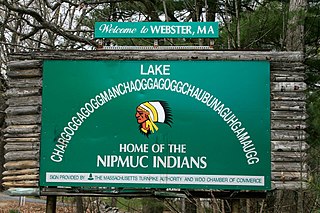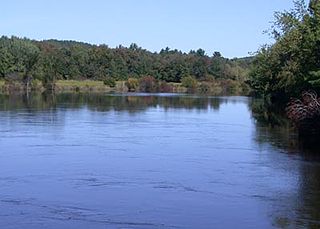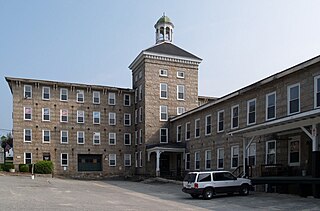Related Research Articles

Oxford is a town in Worcester County, Massachusetts, United States. The population was 13,347 as of the 2020 United States Census.

The Pokanoket are a group of Wampanoag people and the village governed by Massasoit, chief sachem of the Wampanoag people.

The Massachusett were a Native American tribe from the region in and around present-day Greater Boston in the Commonwealth of Massachusetts. The name comes from the Massachusett language term for "At the Great Hill," referring to the Blue Hills overlooking Boston Harbor from the south.

The Chaubunagungamaug Reservation refers to the small parcel of land located in the town of Thompson, Connecticut, close to the border with the town of Webster, Massachusetts, and within the bounds of Lake Chaubunagungamaug to the east and the French River to the west. The reservation is used by the descendants of the Nipmuck Indians of the previous reservation, c. 1682–1869, that existed in the same area, who now identify as the Webster/Dudley Band of the Chaubunagungamaug Nipmuck.
The Pawtucket tribe were a confederation of Eastern Algonquian-speaking Native Americans in present-day northeastern Massachusetts and southeastern New Hampshire. They are mostly known in the historical record for their dealings with the early English colonists in the 17th century. Confusion exists about the proper endonym for this group who are variously referred to in European documents as Pawtucket, Pentucket, Naumkeag, Wamesit, or Mystic Indians, or by the name of their current sachem or sagamore.

John Wingate Thornton was an American lawyer, antiquarian, book collector and writer.

The Nashaway were a tribe of Algonquian Indians inhabiting the upstream portions of the Nashua River valley in what is now the northern half of Worcester County, Massachusetts, mainly in the vicinity of Sterling, Lancaster and other towns near Mount Wachusett, as well as southern New Hampshire. The meaning of Nashaway is "between," an adverbial form derived from "nashau" meaning "someone is between/in the middle" = adverbial suffix "we" Gustafson, Holly (2000), "A Grammar of the Nipmuc Language," University of Manitoba.</ref>

Danyell "Daniel" Gookin was a Munster colonist, settler of Virginia and Massachusetts, and a writer on the subject of American Indians.

Edmund Quincy III was an American merchant and judge. He was the son of Col. Edmund Quincy II (1627-1698) II and his second wife, Elizabeth Gookin. He married Dorothy Flynt and had 7 children. Four lived to adulthood, including Edmund Quincy IV and Dorothy Quincy, who was the topic of a famous poem by Oliver Wendell Holmes Sr.
Wompatuck, also spelled Wampatuck, was sachem, or paramount chief, of the Mattakeesett band of Massachusett Indians.

Ponkapoag, also Punkapaug, Punkapoag, Ponkhapoag or Punkapog, is the name of a Native American "praying town" settled in the late 17th century western Blue Hills area of eastern Massachusetts by persons who had accepted Christianity. It was established in 1657, during the colonization of the Atlantic seaboard of the United States by settlers from Britain. This was the name given to the winter residence of the group of Massachusett who lived at the mouth of the Neponset River near Dorchester in the summer, in what colonists called Neponset Mill.

Daniel Gookin was the first sheriff of Worcester County, Massachusetts.
Nathaniel Gookin Upham was a prominent judge in Concord, New Hampshire. He served as an associate justice of the New Hampshire Supreme Court for ten years. He later became the President of the Concord Railroad. Late in his life, he served in the state legislature and occasionally called upon to mediate disputes between the United States and foreign nations.

The Manchaug Village Historic District is a historic district encompassing the 19th century industrial village center of Manchaug in Sutton, Massachusetts. Developed in the 1820s around textile mills on the Mumford River, it was the largest industrial area in Sutton, with at least three mill complexes in operation. The district is centered on the junction of Main Street with Manchaug, Putnam Hill, and Whitins Roads.
Peter Jethro was an early Native American (Nipmuc) scribe, translator, minister, land proprietor, and Praying Indian affiliated for a period with John Eliot in the praying town of Natick, Massachusetts.

Quashaamit was a bilingual Praying Indian sachem or sub-sachem, and teaching minister. His tribal affiliation may have Nipmuc, Massachusett, and/or Wampanoag.
Daniel Quincy, trained as a silversmith under John Hull, his uncle by marriage. Daniel lived with John and Judith Hull from the age of seven and was trained in the Hull and Sanderson mint on Summer Street (Boston) as a goldsmith producing the pine tree shilling. Hull treated young Daniel as his own son. Daniel and Ann Quincy were married by John Hull Esq.

Daniel Takawambait was likely the first ordained Native American Christian pastor in North America, and served the church in the praying town of Natick, Massachusetts from 1683 to 1716. Takawambait also advocated for indigenous land rights in colonial Massachusetts, and authored at least one publication.

Quinnatisset was a Nipmuc village in Connecticut which became a praying town through the influence of John Eliot and Daniel Gookin. The town was located near what is now Thompson, Connecticut or Pomfret, Connecticut possibly near Thompson Hill Historic District. The name "Quantisset" means "little long river."
Maanexit was a Nipmuc village on the Quinebaug River and Old Connecticut Path in Connecticut. The town was located near what is now Fabyan in Thompson, Connecticut and Woodstock, Connecticut. The name of the town means either "where the road lies" or "where we gather" which may have been "alluding to a settlement of Christian Indians in the immediate vicinity." The village became an Indian praying town through the influence of John Eliot and Daniel Gookin.
References
- ↑ Gookin, Daniel (1674). Collections of the Massachusetts Historical Society: Gookin's Historical Collections of Indians in New England. Robarts - University of Toronto. Boston [etc.] p. 197.